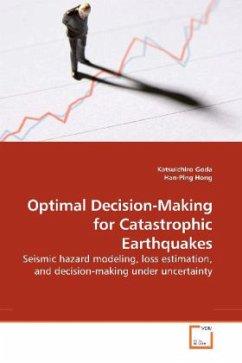
Simulation-Based Decision Making for Complex Systems
Applications in Disaster Response Planning and Management
Versandkostenfrei!
Versandfertig in 6-10 Tagen
45,99 €
inkl. MwSt.

PAYBACK Punkte
23 °P sammeln!
Over the last several decades, computer simulationshave been widely utilized to model and analyzecomplex systems at low costs and risks. Althoughsimulation can represent physical systemsrealistically, it is a descriptive tool without thecapability of suggesting better solutions. However,it can be complemented by incorporating optimizationroutines. The most challenging problem is thatlarge-scale simulation models normally take aconsiderable amount of computer time to execute sothat the number of solution evaluations needed bymost optimization algorithms is not feasible within areasonable time f...
Over the last several decades, computer simulations
have been widely utilized to model and analyze
complex systems at low costs and risks. Although
simulation can represent physical systems
realistically, it is a descriptive tool without the
capability of suggesting better solutions. However,
it can be complemented by incorporating optimization
routines. The most challenging problem is that
large-scale simulation models normally take a
considerable amount of computer time to execute so
that the number of solution evaluations needed by
most optimization algorithms is not feasible within a
reasonable time frame. This book, therefore, provides
a highly efficient evolutionary simulation-based
decision making procedure which can be applied in
real-time management situations. We have used this
novel simulation-optimization technique to study
several disaster response problems. The methodologies
provided herein should be useful to professionals and
researchers in the fields of industrial engineering
and operations research. The applications in disaster
response management should help emergency managers
and personnel to gain insights into several
significant response problems.
have been widely utilized to model and analyze
complex systems at low costs and risks. Although
simulation can represent physical systems
realistically, it is a descriptive tool without the
capability of suggesting better solutions. However,
it can be complemented by incorporating optimization
routines. The most challenging problem is that
large-scale simulation models normally take a
considerable amount of computer time to execute so
that the number of solution evaluations needed by
most optimization algorithms is not feasible within a
reasonable time frame. This book, therefore, provides
a highly efficient evolutionary simulation-based
decision making procedure which can be applied in
real-time management situations. We have used this
novel simulation-optimization technique to study
several disaster response problems. The methodologies
provided herein should be useful to professionals and
researchers in the fields of industrial engineering
and operations research. The applications in disaster
response management should help emergency managers
and personnel to gain insights into several
significant response problems.












